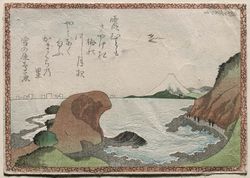Difference between revisions of "Category:Carbon black:Ukiyo-e colorant"
| Line 4: | Line 4: | ||
<font size="3">'''[[Carbon black]]'''</font> 墨(''sumi''): A fine particle carbon pigment obtained as soot from the incomplete combustion of many different types of organic materials. The soot is mixed with animal glue (膠 ''nikawa'') to produce ink sticks. In Japan, the two main types of carbon black are [[Lampblack|lamp black]] and [[Pine-soot black|pine soot black]]. Lamp black (油煙墨 ''yuen zumi'') is usually made from [[Rapeseed oil|rapeseed oil]] as well as [[Sesame oil|sesame oil]] and other oils. Pine soot black (松煙墨 ''shoen zumi'') is made by burning fallen pine wood or collected resin. While the color can range from a brownish to bluish black, lamp blacks are usually dark black and pine soot blacks are bluish black. | <font size="3">'''[[Carbon black]]'''</font> 墨(''sumi''): A fine particle carbon pigment obtained as soot from the incomplete combustion of many different types of organic materials. The soot is mixed with animal glue (膠 ''nikawa'') to produce ink sticks. In Japan, the two main types of carbon black are [[Lampblack|lamp black]] and [[Pine-soot black|pine soot black]]. Lamp black (油煙墨 ''yuen zumi'') is usually made from [[Rapeseed oil|rapeseed oil]] as well as [[Sesame oil|sesame oil]] and other oils. Pine soot black (松煙墨 ''shoen zumi'') is made by burning fallen pine wood or collected resin. While the color can range from a brownish to bluish black, lamp blacks are usually dark black and pine soot blacks are bluish black. | ||
| − | Carbon black can be printed to produce a range of gray to blacks but can also be mixed with other colorants to darken a color. In early handcolored prints called urushi-e, animal glue was added to carbon black, which gave it a sheen like lacquer, or ''urushi''. Printed black areas including the lines are most likely lamp black. Carbon black can also be added to other colorants to darken the color although it has not been found often. Black areas are also sometimes manipulated by embossing to create patterns within the area or | + | Carbon black can be printed to produce a range of gray to blacks but can also be mixed with other colorants to darken a color. In early handcolored prints called urushi-e, animal glue was added to carbon black, which gave it a sheen like lacquer, or ''urushi''. Printed black areas including the lines are most likely lamp black. Carbon black can also be added to other colorants to darken the color although it has not been found often. Black areas are also sometimes manipulated by embossing or burnishing to create patterns within the area or to create a sheen, which is frequently done to depict lacquerware. Bluish gray areas which do not produce an analytical result of blue, may be pine soot black. |
'''For more information see:''' [[Carbon black]], [[Lampblack]], [[Pine-soot black|Pine soot black]] | '''For more information see:''' [[Carbon black]], [[Lampblack]], [[Pine-soot black|Pine soot black]] | ||
Revision as of 11:54, 2 June 2020
Carbon black 墨(sumi): A fine particle carbon pigment obtained as soot from the incomplete combustion of many different types of organic materials. The soot is mixed with animal glue (膠 nikawa) to produce ink sticks. In Japan, the two main types of carbon black are lamp black and pine soot black. Lamp black (油煙墨 yuen zumi) is usually made from Rapeseed oil as well as Sesame oil and other oils. Pine soot black (松煙墨 shoen zumi) is made by burning fallen pine wood or collected resin. While the color can range from a brownish to bluish black, lamp blacks are usually dark black and pine soot blacks are bluish black.
Carbon black can be printed to produce a range of gray to blacks but can also be mixed with other colorants to darken a color. In early handcolored prints called urushi-e, animal glue was added to carbon black, which gave it a sheen like lacquer, or urushi. Printed black areas including the lines are most likely lamp black. Carbon black can also be added to other colorants to darken the color although it has not been found often. Black areas are also sometimes manipulated by embossing or burnishing to create patterns within the area or to create a sheen, which is frequently done to depict lacquerware. Bluish gray areas which do not produce an analytical result of blue, may be pine soot black.
For more information see: Carbon black, Lampblack, Pine soot black
Examples of Carbon black in Ukiyo-e Prints

|

|

|

|

|
Analysis
Excitation Emission Matrix (EEM) spectroscopy can easily identify the organic reds: safflower, madder, and sappanwood. Madder fluoresces brightly under UVA radiation and produces a unique EEM pattern that helps differentiate it from safflower, which also fluoresces.
Other Images of Carbon black
Add image of ink stick
This category currently contains no pages or media.




